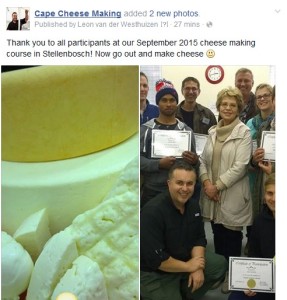Raw Milk
Cheese Making Courses – South Africa – Intro
Cheese Making Courses – South Africa
For info on cheese courses email info@cheesemaking.co.za
Cheese Making Courses – South Africa
We have now arranged three courses in various provinces for February 2016.
They are as follows:
9 & 10 February 2016 in Pretoria NW to be held at – The Blue Pot Deli
12 & 13 February 2016 in Clarens OFS to be held at Dunelm Guestfarm
16 & 17 February 2016 in Mooiriver KZN to be held at St. Andrews Retreat
We present cheese making courses on invite in :
The Eastern Cape
The Free State
Gauteng
KwaZulu-Natal
Limpopo
Mpumalanga
The Northern Cape
North West
The Western Cape
We love Stellenbosch, Cape Town, Hartebeespoortdam, Clarens
Join us for a cheesemaking course by contacting elaine@alivingway.com

one of our cheese courses
We had a great cheese course!
Grow a Goatee!
www.nwfdailynews.com/article/5254
Drink your goat milk!
Cheerio,
Leon the Milkman
Enzymes in milk
Hi, Milk Fans
Milk contains a number of enzymes, that include lipase, protease, alkaline phosphatase, acid phosphatase, esterase, xanthine oxidase, lactoperoxidase, catalase, aldolase and lysozyme.
Remember to drink your milk,
Leon the Milkman
Freezing milk bulk tank
Hi, Milk Fans
If your bulk tank is freezing it’s set too cold and you stand a chance of developing rancidity in the milk. This is because the formed ice crystals puncture the fat globules, releasing lipase. Be sure to not switch the tank on too early – some people like to do this to give the tank a “running start”, before the milk is pumped in.
When the milk freezes, it also concentrates the milk solids, making the milk sweet and increasing the viscosity.
Kind regards,
Leon the Milkman
Standardizing milk
Hi, Milk Fans
Why should milk be standardised?
So that the consumer knows what they are buying. At the moment on the drinking milk market we pay the same price for Friesian milk with a 3.3% butterfat and 3% protein score as for Jersey milk with a 4.5% butterfat and 3.8% protein content.
This should not be making sense to the consumer or to the farmer! Should milk be standarized by mixing with other milk or with water?  Will consumers be up for this?
Please feel free to give your opinion on the forum at www.dairy-info.org
Kind Regards,
Leon the Milkman
Milking cows is good for you!
Hi, Cow fans
If you are interested in milking, read this interesting article:
Kind regards,
Leon the Milkman
Pasteurizing cheese milk at home
Hi, Cheese fans
If you want to pasteurize raw milk at home for cheese making it is best to use two form fitting pots like on the photo. Fill the gap between the pots with water and make sure that the inside pot is hanging so that there is also some water under the bottom.
This is much like the set-up you would use to melt chocolate.  Heat the milk to 65°C and keep it there for 5 minutes – then cool it down with cold or ice water in the kitchen sink.
For cheese making the milk should be cooled to 32°C and for drinking it should be cooled to at leat 8°C and then refrigerated to cool it down further.
This method can of course be used for pasteurizing goat milk at home or any other milk for that matter.
Kind regards,
Leon the Milkman
Balanced Milk
Hi, Milk Fans
You know why I always say milk is balanced?
Well if you look at the composition of cow and goat milk, you will see that the fat, protein and lactose(carbohydrate) is more balanced than in almost any other food. This helps regulate blood sugar and gives you all-round nourishment throughout the day.
Kind regards,
Leon the Milkman
High Coliforms in raw milk?
Hi, Dairy Farmers
Do you have high coliform bacteria counts on raw milk?
The reasons could be infection, even something like dust from construction taking place on your premises.
Another reason – your bulk tank could be taking too long to cool the milk after milking. Top farmers shoot for all the milk to be chilled to under 4°C in half an hour, but most will go for 2 hours. If it takes longer than this, you are looking for trouble.
Do not however set the bulk tank to such low temperatures that the first milk into the tank freezes – this will pop fat globules that can contribute to oiling off (lower butterfat analyses – less money to you) or rancidity, because lipase will be released.
Kind regards,
Leon the Milkman
